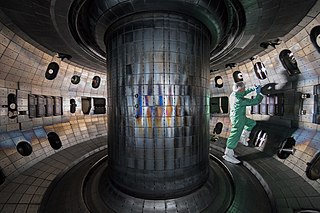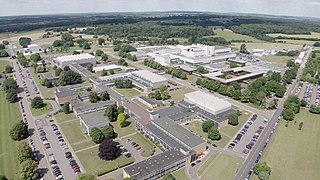Related Research Articles

A tokamak is a device which uses a powerful magnetic field to confine plasma in the shape of a torus. The tokamak is one of several types of magnetic confinement devices being developed to produce controlled thermonuclear fusion power. As of 2016, it was the leading candidate for a practical fusion reactor. The word "tokamak" is derived from a Russian acronym meaning "toroidal chamber with magnetic coils".

Princeton Plasma Physics Laboratory (PPPL) is a United States Department of Energy national laboratory for plasma physics and nuclear fusion science. Its primary mission is research into and development of fusion as an energy source. It is known for the development of the stellarator and tokamak designs, along with numerous fundamental advances in plasma physics and the exploration of many other plasma confinement concepts.

Fusion power is a proposed form of power generation that would generate electricity by using heat from nuclear fusion reactions. In a fusion process, two lighter atomic nuclei combine to form a heavier nucleus, while releasing energy. Devices designed to harness this energy are known as fusion reactors. Research into fusion reactors began in the 1940s, but as of 2024, no device has reached net power, although net positive reactions have been achieved.
This timeline of nuclear fusion is an incomplete chronological summary of significant events in the study and use of nuclear fusion.

The Joint European Torus (JET) was a magnetically confined plasma physics experiment, located at Culham Centre for Fusion Energy in Oxfordshire, UK. Based on a tokamak design, the fusion research facility was a joint European project with the main purpose of opening the way to future nuclear fusion grid energy. At the time of its design JET was larger than any comparable machine.

ITER is an international nuclear fusion research and engineering megaproject aimed at creating energy through a fusion process similar to that of the Sun. Upon completion of construction of the main reactor and first plasma, planned for late 2025, it will be the world's largest magnetic confinement plasma physics experiment and the largest experimental tokamak nuclear fusion reactor. It is being built next to the Cadarache facility in southern France. ITER will be the largest of more than 100 fusion reactors built since the 1950s, with ten times the plasma volume of any other tokamak operating today.

The ENSTA Paris, officially École nationale supérieure de techniques avancées is a prestigious French graduate school of engineering. Founded in 1741, it is the oldest "grande école" in France. It is located in Palaiseau in the south of Paris, on the Paris-Saclay campus, and is a constituent faculty of the Polytechnic Institute of Paris. In 2021, 180 engineers graduated from the school.

Magnetic confinement fusion (MCF) is an approach to generate thermonuclear fusion power that uses magnetic fields to confine fusion fuel in the form of a plasma. Magnetic confinement is one of two major branches of controlled fusion research, along with inertial confinement fusion.

The KSTAR is a magnetic fusion device at the Korea Institute of Fusion Energy in Daejeon, South Korea. It is intended to study aspects of magnetic fusion energy that will be pertinent to the ITER fusion project as part of that country's contribution to the ITER effort. The project was approved in 1995, but construction was delayed by the East Asian financial crisis, which weakened the South Korean economy considerably; however, the project's construction phase was completed on September 14, 2007. The first plasma was achieved in June 2008.

Robert Aymar was the Director General of CERN (2004–2008), serving a five-year term in that role.

Evgeny Pavlovich Velikhov is a physicist and scientific leader in the Russian Federation. His scientific interests include plasma physics, lasers, controlled nuclear fusion, power engineering, and magnetohydrodynamics. He is the author of over 1500 scientific publications and a number of inventions and discoveries.
Ignitor is the Italian name for a planned tokamak device, developed by ENEA. As of 2022, the device has not been constructed.
Derek Charles Robinson FRS was a physicist who worked in the UK fusion power program for most of his professional career. Studying turbulence in the UK's ZETA reactor, he helped develop the reversed field pinch concept, an area of study to this day. He is best known for his role in taking a critical measurement on the T-3 device in the USSR in 1969 that established the tokamak as the primary magnetic fusion energy device to this day. He was also instrumental in the development of the spherical tokamak design though the construction of the START device, and its follow-on, MAST. Robinson was in charge of portions of the UK Atomic Energy Authority's fusion program from 1979 until he took over the entire program in 1996 before his death in 2002.

The Culham Centre for Fusion Energy (CCFE) is the UK's national laboratory for fusion research. It is located at the Culham Science Centre, near Culham, Oxfordshire, and is the site of the Joint European Torus (JET), Mega Ampere Spherical Tokamak (MAST) and the now closed Small Tight Aspect Ratio Tokamak (START).

In nuclear fusion power research, the plasma-facing material (PFM) is any material used to construct the plasma-facing components (PFC), those components exposed to the plasma within which nuclear fusion occurs, and particularly the material used for the lining the first wall or divertor region of the reactor vessel.

Sir Steven Charles Cowley is a British theoretical physicist and international authority on nuclear fusion and astrophysical plasmas. He has served as director of the United States Department of Energy (DOE) Princeton Plasma Physics Laboratory (PPPL) since 1 July 2018. Previously he served as president of Corpus Christi College, Oxford, since October 2016. and head of the EURATOM / CCFE Fusion Association and chief executive officer of the United Kingdom Atomic Energy Authority (UKAEA).
Hartmut Zohm is a German plasma physicist who is known for his work on the ASDEX Upgrade machine. He received the 2014 John Dawson Award and the 2016 Hannes Alfvén Prize for successfully demonstrating that neoclassical tearing modes in tokamaks can be stabilized by electron cyclotron resonance heating, which is an important design consideration for pushing the performance limit of the ITER.

The Wigner fusion research groups are involved in magnetically confined nuclear fusion experiments around the world. Wigner fusion consists of research groups from four different research institutes and universities, 3 if which are located in the Department of Plasma Physics at the Wigner Research Centre for Physics, one in the Institute of Nuclear Techniques (INT) of the Budapest University of Technology and Economics other specialist are involved from the Centre for Energy Research and from the Institute for Nuclear Research of the Hungarian Academy of Sciences, in the coordination of the Wigner Research Centre for Physics. Wigner fusion connected to the European fusion research programme through EUROfusion consortium which coordinated fusion research in Europe. At Wigner fusion more than 40 researchers, engineers and technicians work together in these research groups who are involved in more than half a dozen magnetic confinement experiments around the world, such as ITER, JET, Asdex-Upgrade, W7-X, KSTAR, EAST, MAST-Upgrade and COMPASS.

Ambrogio Fasoli is a researcher and professor working in the field of fusion and plasma physics. A Fellow of the American Physical Society, he is Director of the Swiss Plasma Center, located at EPFL, the Swiss Federal Institute of Technology in Lausanne, Switzerland. Since 1 January 2019, he chairs the European consortium EUROfusion, the umbrella organisation for the development of nuclear fusion power in Europe.
Donato Palumbo was an Italian physicist best known as the leader of the European Atomic Energy Community (Euratom) fusion research program from its formation in 1958 to his retirement in 1986. He was a key force in the development of the tokamak during the 1970s and 80s, contributing several papers on plasma confinement in these devices and leading the JET fusion reactor program, which as of 2021, retains the record for the closest approach to breakeven, the ratio between the produced fusion power and the power used to heat it. He is referred to as the founding father of the European fusion program.
References
- ↑ C.M.Braams, P.E.Stott(2002), Nuclear Fusion: half a century of magnetic confinement fusion research, Institute of Physics Publishing, Bristol, UK, ISBN 0-7503-0705-6